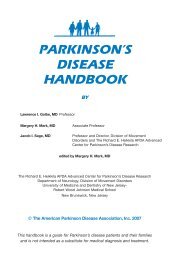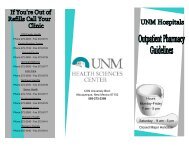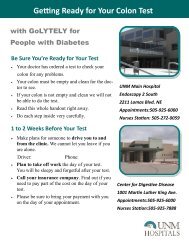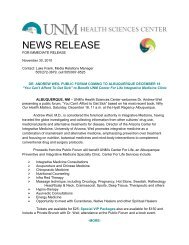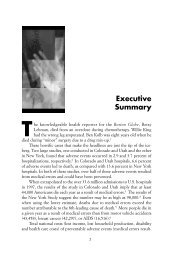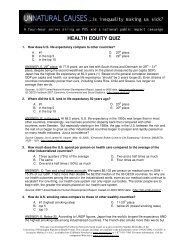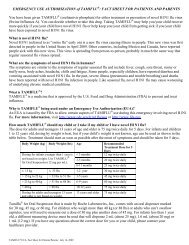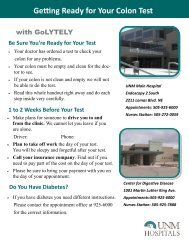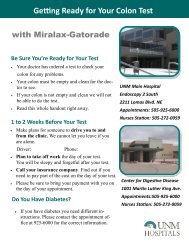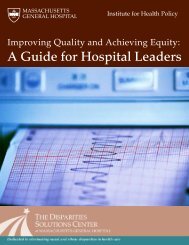Advanced Effective Communication, Cultural Competence, and ...
Advanced Effective Communication, Cultural Competence, and ...
Advanced Effective Communication, Cultural Competence, and ...
You also want an ePaper? Increase the reach of your titles
YUMPU automatically turns print PDFs into web optimized ePapers that Google loves.
A Roadmap for Hospitals<br />
Appendix D: Laws <strong>and</strong> Regulations<br />
(NIH), or other federal funds. Title VI protection generally<br />
extends to all programs <strong>and</strong> activities of any health care entity<br />
receiving federal financial assistance, whether or not the particular<br />
program at issue has itself received those funds [2].<br />
According to the HHS implementing regulation for Title VI,<br />
a hospital that receives federal financial assistance may not,<br />
based on race, color, or national origin:[3]<br />
• Deny services, financial aid, or other benefits provided as a<br />
part of health or human service programs<br />
• Provide a different service, financial aid or other benefit,<br />
or provide them in a different manner from those provided<br />
to others under the program<br />
• Segregate or separately treat individuals in any matter related<br />
to the receipt of any service, financial aid, or other benefit<br />
Revised HHS LEP Guidance—<strong>Effective</strong><br />
Practices for Title VI Compliance<br />
The Revised HHS LEP Guidance provides an analytical framework<br />
that hospitals may use to determine how to best comply<br />
with obligations to provide meaningful access for individuals<br />
who are limited English proficient to the benefits, services, information,<br />
<strong>and</strong> other important portions of their programs <strong>and</strong><br />
activities [4].* While designed to be a flexible <strong>and</strong> factdependent<br />
st<strong>and</strong>ard, the starting point for an individualized<br />
LEP assessment should balance the following four factors:<br />
1. The number or proportion of LEP persons eligible to be<br />
served or likely to be encountered by the program or<br />
grantee<br />
2. The frequency with which LEP individuals come in<br />
contact with the program<br />
3. The nature <strong>and</strong> importance of the program, activity, or<br />
service provided by the program to people’s lives<br />
4. The resources available to the hospital <strong>and</strong> costs<br />
The Revised HHS LEP Guidance seeks to suggest a balance<br />
between allowing access by LEP persons to critical services<br />
while not imposing undue burdens on small business, small<br />
local governments, or small nonprofits.<br />
Highlighted in the next section are several tips <strong>and</strong> tools contained<br />
in the Revised HHS LEP Guidance, including how to<br />
develop an effective LEP implementation plan, interpreter<br />
competency, <strong>and</strong> translation of written documents.<br />
Typical Elements in <strong>Effective</strong> LEP<br />
Implementation Plans<br />
While an LEP implementation plan is not required, should a<br />
hospital decide to develop such a plan, the Revised HHS LEP<br />
Guidance document provides five elements for making the<br />
plan most effective: †<br />
1. Identify LEP individuals who need language assistance.<br />
The first two factors in the analytical framework require<br />
the hospital to assess the number or proportion of LEP<br />
individuals eligible to be served or encountered <strong>and</strong> the<br />
frequency of encounters. Accordingly, this step requires a<br />
hospital to underst<strong>and</strong> how it will identify LEP persons<br />
with whom it has contact <strong>and</strong>/or could have contact.<br />
2. Describe language assistance measures. Include information<br />
about the ways in which the hospital will provide language<br />
assistance. For instance, hospitals may want to include<br />
information on at least the following items:<br />
• Types of language services available<br />
• How staff can obtain those services<br />
• How staff should respond to LEP callers<br />
• How staff should respond to written communications<br />
from LEP persons<br />
• How staff should respond to LEP individuals who have<br />
in-person contact with hospital staff<br />
• How to ensure competency of interpreters <strong>and</strong><br />
translation services<br />
3. Train staff. Construct a process for identifying staff who<br />
need LEP plan training, design a plan for training them, <strong>and</strong><br />
determine the desired outcomes of the training. An effective<br />
LEP plan may include training all staff on LEP policies <strong>and</strong><br />
procedures <strong>and</strong> staff who have contact with the public to<br />
work effectively with in-person <strong>and</strong> telephone interpreters.<br />
4. Provide notice to LEP persons. Describe the process by<br />
which the hospital will notify LEP persons the hospital<br />
serves or, to the extent that a service area exists, LEP<br />
persons that reside in its service area <strong>and</strong> are eligible for<br />
services of the LEP services that are available.<br />
5. Monitor <strong>and</strong> update the LEP plan. Identify a process for the<br />
hospital to monitor its implementation of the LEP plan <strong>and</strong><br />
* Note that the HHS LEP policy guidance is not a regulation but rather a guide, <strong>and</strong> that portions excerpted in this section are not reproduced in<br />
their entirety. The entire document is available at http://www.hhs.gov/ocr/civilrights/resources/specialtopics/lep/policyguidancedocument.html; a<br />
summary of the guidance is available at http://www.hhs.gov/ocr/civilrights/resources/laws/summaryguidance.html. The Revised HHS LEP Guidance<br />
“Q&A” can be found at http://www.hhs.gov/ocr/civilrights/resources/specialtopics/lep/finalproposed.html.<br />
† See full discussion at pp. 17–19 of the HHS LEP Guidance.<br />
66



